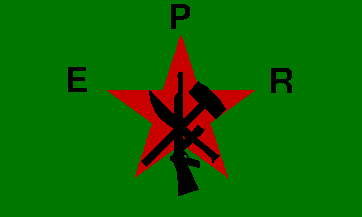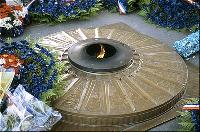The flag of
the Popular Revolutionary Army (EPR) of Mexico
from http://www.ace.unsw.edu.au/fotw/flags/mx-epr.html
by Dave Martucci, 1995-12-19 The flag of the Popular Revolutionary Army
(EPR) of Mexico is shown in a photograph in "US News and World Report," 1996-09-23
issue, page 61. It has a green field with a red star, superimposed over which
are crossed rifle, machete and hammer. Just off the three uppermost points of
the star are the initials of this faction, EPR. The emblems and letters are in
black. Two other flags are also shown in the photo, the Mexican Flag
and another revolutionary flag of what appears to be dark green with a red star
in the center. On the hats of the masked rebels in the photo are emblems, the
bottom half of which is the mexican tricolor (without arms; i.e. "Italy") over
which is a black panel with three red stars. The four rebels in the picture are
wearing red masks over their faces. Another photo accompanying this article
(page 64) shows some black-masked rebels standing under a Mexican Flag. Their
rifles are painted Green-Black-Red. The caption refers to the Zapatista rebels
(another faction) but it is not clear if that is who is pictured in the photo.
Dave Martucci, 1995-12-19
|
| from
http://www.pressenter.com/~dpedersn/
Hispanic Street gangs Hispanic gangs began forming in California
during the early 1920s. They started as
looseknit groups banding together
for unity and socializing in the barrios (neighborhoods) where the same culture,
customs, and language prevailed. Gang members were male youths ranging from 14-
to 20-years-old. Property crimes such as burglary, strong-arm robbery, and vandalism
were their crimes of choice. These gangs had no formal structure nor leadership.
They were very defensive of their barrio, and they would protect it with a vengeance.
Gang fights occurred between rival gangs as a result of disputes, turf differences,
or transgressions--whether real or imaginary. Often, their weapons included knives,
zip guns, chains, clubs, rocks, and bottles. The commission of a crime became
a way of gaining status within the gang. Imprisonment in the California Youth
Authority or the California Department of Corrections earned a gang member great
stature with other gang members. By the 1980s, these gangs began targeting their
communities and surrounding
neighborhoods for drive-by shootings, assaults,
murders, and other felonious crimes.
Violence became a way of life. The gangs
developed some organization and structure, and leaders emerged from the ranks
of older gang members who had been stabbed or shot in gang fights or released
from the youth authority or prison. Known as "veteranos," these gang leaders began
to recruit new members and train them in gang-related criminal activities. They
continued to be turf oriented, and gang fights progressed to gang wars. The age
span for gang members widened, encompassing male youths ranging from 12- to 25-years-old
who were willing to fight and die for the gang. Most of the gangs required new
members to commit a crime, such as stealing a car or committing a burglary or
robbery, before becoming a gang member. As the Hispanic gang members evolved,
they established unique trademarks such tattoos, hand signs, monikers, and graffiti.
Elaborate tattoos depicting the initials or name of a gang symbolized loyalty
to a particular gang. Hand signs formed the letters of the gang's initials. Monikers
were names assumed by--or given to--gang members, and they were usually retained
for life. Intricate graffiti--or placa--clearly marked the gang's territorial
boundaries and served as a warning to rival gangs. Gang members used these distinguishing
characteristics to demonstrate gang allegiance, strengthen gang participation,
and challenge rival gangs. The Department of Justice estimates there could be
as many as 95,000 Hispanic gang members in California today. Located in all of
the major metropolitan cities, these gangs vary in size from a few members to
several hundred. The gang members range in age from 12- to 40-years-old, and many
are second- or third-generation gang members. Adult Hispanic gang members recruit
and use juvenile gang members to commit crimes or carry weapons because juveniles
are subject to less severe sentences compared to adult penalties. Juvenile gang
members are often arrested numerous times before actually serving time in jail
or the California Youth Authority. Recruitment of new gang members often requires
the prospective member to commit a drive-by shooting or some other form of felonious
assault. Loyalty to their gang usually extends to their death. Reliance on tattoos,
hand signs, and graffiti continues to dominate the gangs' characteristics. These
symbols are frequently used to threaten rival gangs besides endorsing allegiance
to their own gang. Their criminal activities now range from robberies, burglaries,
grand thefts, vehicle thefts, receiving stolen property to assaults, batteries,
drive-by shootings, and murders. They are becoming involved as entrepreneurs in
the selling of narcotics--particularly PCP, Mexican tar heroin, methamphetamine,
and marijuana. The gangs' arsenals have expanded to large-caliber handguns, shotguns,
and automatic weapons; and their crimes are becoming more violent. Hispanic gang
members were responsible for approximately 80 gang-related drive-by shootings
in Stockton, California, during 1991. Gang members will attack rival gangs in
defense of their turf. The Eastside Longos--a Hispanic gang in Long Beach, California--has
been involved in a gang war since October 1989 with the Tiny Rascal Gangsters--a
Cambodian gang also located in Long Beach and in several other parts of the state
including Fresno and San Diego. Drive-by shootings and assaults between these
two gangs have resulted in 16 killings thus far. Law enforcement is an increasing
target of gang violence. Hispanic gangs in the Los Angeles area, such as the Harbor
City and the "Crazy," have attacked both on and off-duty officers. A few of the
gangs are beginning to recruit non-Hispanic gang members, and some Hispanic gang
members are joining different ethnic gangs. Various Hispanic gangs are aligning
with other ethnic gangs, usually from the same neighborhood. This affiliation
allows them more neighborhood protection from rival gangs. Hispanic female gangs
are starting to evolve exclusive of the traditionally male-dominated Hispanic
gangs. Some of the female gang members, such as the Fresno Bulldog Babes, are
participating in drive-by shootings, auto thefts, and assaults.
|
| from http://www.tampabayonline.net/news/apbreak.htm
8/26/98 -- 5:42 AM Detective Mark Fuhrman's legacy: LAPD
reform LOS ANGELES (AP) - Detective Mark Fuhrman leaped into
history when he jumped the gate
at O.J. Simpson's house and found a
bloody glove matching one he had discovered earlier at
Nicole Brown
Simpson's condo. More than four years later, however, Fuhrman's
biggest impact on the Los Angeles Police
Department
remains his ``egregious, systemic misconduct,'' which came to light
in the
Simpson investigation, according to reports by Chief Bernard
Parks. The department's Mark Fuhrman Task Force has identified
23 areas
where it can take action to prevent lying, racism, sexual harassment,
excessive force and creating a hostile work environment. Of
those, 12 have been addressed and the rest can be taken care of
by
the end of the year, Parks reported Tuesday. The recommendations
were developed by Internal Affairs investigators
who spent 17 months
researching Fuhrman and stories he told to writer
Laura Hart McKinny
in a series of interviews during the 1980s. The report called on
the LAPD to revise its approach to discipline and
recommended more thorough
investigation of officer histories. The statements to McKinny were
used to discredit Fuhrman's testimony,
a critical part of Simpson's
criminal trial. Fuhrman's use of racist epithets and boasts about
police brutality and
sexism undermined his credibility. Simpson was
acquitted of murder
charges, although he was later held liable for the
killings in a civil trial. After Simpson's criminal trial, Fuhrman
pleaded no contest to a perjury
charge after the tapes proved he lied
when he denied on the witness
stand that he had used a racial
epithet during the previous 10 years.
He was sentenced to probation
and fined $200. Fuhrman later said that racially charged statements
made to McKinny
were exaggerations or fabrications created for her screenplay.
He has
since retired and moved to Idaho. Copyright 1998
Associated Press. All rights reserved.
This material may
not be published, broadcast, rewritten, or redistributed.
|
8 Chinese stowaways found dead in Japan
Copyright © 1998 Nando.net
Copyright © 1998 Reuters News
Service TOKYO (August 17, 1998 8:42 p.m. EDT http://www.nandotimes.com)
- Port officials in Tokyo discovered eight dead Chinese stowaways
who
appeared to have been trying to enter Japan illegally on board a container
ship,
a Maritime Agency official said on Tuesday. Another eight
were discovered alive on Monday, but weak from dehydration,
in a container
on board the 2,900-ton freighter Goldrich River, the official said. The
survivors, five men and three women, were hospitalized,
and the men
were arrested by Japanese authorities for illegal entry, he said. Seven
of the eight people found dead were women, who succumbed to temperatures
that rose to 50 C (122 F) inside the compartment. The survivors told
authorities they had boarded the ship,
registered in the St. Vincent
and the Grenadines, in the northern Chinese port of Dalian. A Maritime
Agency official said the ship's captain heard cries coming from the container
on Sunday, but the container was only opened after the Goldrich River
arrived in Tokyo on Monday afternoon. "Under maritime law, it's up
to the captain to decide when to inspect the hold for stowaways,
so
we really can't comment on why he waited," a Maritime Agency official said.
|
| from VCT
newsclip "...despite the commitment of 11,000 federal agents" "In
other words, despite the commitment of 11,000 federal agents,
the nation is
still losing the battle of the border. While there is no way of ensuring that
his plan will help, McCaffrey said that after two years of studying
the drug battles at the border, he is ready to try. The retired four-star general
believes the United States suffers not only from a shortage of border resources
but also from a lack of coordination among the federal agencies that police the
border. They include the Customs Service, the Immigration and Naturalization Service,
the National Guard, the Drug Enforcement Administration and the Agriculture Department."
|
| from http://www.tampabayonline.net/news/apbreak.htm
(link expired) 7/1/98 -- 9:00 PM  Officials
relight France's eternal flame after `unspeakable act' Officials
relight France's eternal flame after `unspeakable act' PARIS (AP)
- French and Mexican officials re-lit the eternal flame under the Arc de Triomphe
on Wednesday after two Mexican tourists extinguished it by urinating on
it. Mexico's ambassador to France, Sandra Fuentes, laid a wreath
by the flame, which commemorates the nation's war dead. A statement
by the Defense Ministry said the flame was ``soiled'' in an ``unspeakable act.''
``This has been an attack on the memory of those who died for France,
and their honor,'' the statement said. It did not elaborate, but
a member of the Committee for the Flame, speaking on condition of anonymity, said
police caught two drunken Mexicans late Tuesday night after they urinated on the
flame. The man and woman were questioned and released, their embassy
said. Members of the Committee for the Flame and police guard the
flame day and night. Robert Combres, one of about 20 veterans attending
the ceremony, said the incident should not distract attention from France's war heroes.
``This place of remembrance is very important to us since it represents
all our colleagues who lost their lives,'' Combres said. ``Whatever happened,
nothing can take away from that.'' A spokeswoman for the Mexican
Embassy in Paris, Anne Morales, called the affair ``an accident'' and said she
did not expect ties between the nations to be greatly affected. Copyright
1998 Associated Press. All rights reserved. * Additional links by user
request: (4th of July, 2000)
* July
13th, 1998: Dateline: France--Meanwhile, the Gallic land continues to revel in
the fallout from World Cup fever. The international soccer championship continues
to bring out the finest in national pride. Just last Wednesday, a drunken Mexican
soccer fan "extinguished" the eternal flame burning under Paris' Arc de Triomphe.
Twenty-four-year-old Rodrigo Rafael Ortega was arrested for "offending
the dead" and for being drunk in public. The flame has been burning since 1921
over the grave of an unknown French soldier who died in World War I. The War Veterans
Ministry said Mexican Ambassador Sandra Berain and the French Junior Minister
for War Veterans, Jean-Pierre Masseret, were "deeply hurt" by the "unspeakable
act." The beer-bloated Ortega is believed to have extinguished the flame au naturale,
if you catch my drift.
* Nothing
is permanent, witness the dousing of the eternal flame over the Tomb of the
Unknown Soldier in the Arc de Triomphe by a drunken Mexican fan. The
flame was re-lit, as was the most important aspect of this or any World Cup. I
refer not to victory or defeat, or sometimes more depressingly no score and rotten
penalty shoot-outs. Rather to the spirit of carnival around the stadiums, around
the 10 cities, around France.
* "We
are deeply hurt by this unspeakable act." French junior minister for war
veterans Jean-Pierre Masseret on Mexican fan Rodrigo Rafael Ortega, who
extinguished the eternal flame at the tomb of the unknown soldier in Paris by
urinating on it
* Eternal
flame succumbs to beer PARIS -- A Mexican football fan incurred the wrath
of the host nation yesterday after being arrested for putting out the 77-year-old
eternal flame at the Arc de Triomphe. The man doused the flame at the site of
the unknown soldier with a glass of beer and was arrested on public drunkenness
and disturbance of the peace charges. The Mexican ambassador was at a special
ceremony last night to relight the flame. -- Sapa-DPA
* Another
bad decision. Two Mexican tourists, whose names were not released, have
gotten inna little trouble in Paris. In their drunken state, it seems they felt
that the City of Lights had one light too many. When visiting the Arc de Triomphe,
they extinguished its Eternal Flame - which commemorates France's war dead - by
urinating on it. The French were not amused. Mexico's Ambassador to France, Sandra
Fuentes, laid a wreath by the flame while assisting in the re-lighting, so as
not to piss away any good relations between the two countries.
|


